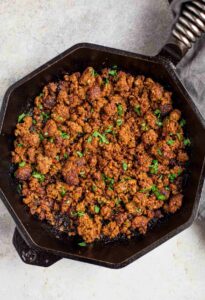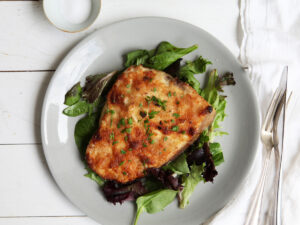Bone broth is a flavorful and nutritious liquid made by simmering bones (and sometimes meat) in water for an extended period. Originating from ancient cultures, it has been cherished for its potential health benefits, including supporting joints, improving skin, and boosting immunity. Bone broth is celebrated for its rich, savory taste and collagen-packed texture, making it a comforting and healing food.
Over time, bone broth has become a trendy ingredient for soups, stews, and even as a standalone drink. This guide will walk you through creating the perfect homemade bone broth with easy-to-follow steps, tips, and variations to cater to different tastes and dietary needs.
Ingredients
To make a delicious homemade bone broth, you will need the following ingredients:
- Bones (2-3 pounds) – beef, chicken, pork, or lamb bones (preferably with some meat attached)
- Water (12 cups) – filtered or spring water works best
- Apple cider vinegar (2 tablespoons) – helps extract minerals from the bones
- Onions (2 medium) – roughly chopped (no need to peel)
- Carrots (3 medium) – chopped into large pieces
- Celery stalks (2) – chopped
- Garlic cloves (4) – smashed
- Bay leaves (2-3)
- Fresh thyme (2 sprigs) or dried thyme (1 teaspoon)
- Peppercorns (1 tablespoon)
- Salt (to taste, start with 1 teaspoon)
- Optional: Herbs like rosemary, parsley, or ginger for additional flavor
Substitutions for Dietary Preferences:



- For vegetarian/vegan options, replace bones with vegetable scraps and add seaweed for mineral content.
- For low-carb diets, ensure no added sugars in vegetables or stock cubes.
- For gluten-free options, be sure to check for any hidden gluten in seasonings or stock cubes.
Step-by-Step Cooking Instructions
-
Prepare the Bones:
- If using beef or pork bones, roast them in the oven at 400°F for 30 minutes for added flavor. (Optional but recommended)
- If using chicken bones, this step can be skipped.
-
Combine Ingredients:
- In a large stockpot, place the bones and cover them with water. Add apple cider vinegar and let the bones sit for 20 minutes to help extract nutrients.
-
Add Vegetables and Seasoning:
- Add chopped onions, carrots, celery, garlic, herbs, bay leaves, peppercorns, and salt.
-
Bring to a Boil:
- Bring the mixture to a boil over high heat. Skim off any foam or impurities that rise to the surface with a spoon.
-
Simmer Slowly:
- Reduce heat to low and simmer the broth uncovered for 12-24 hours. The longer you simmer, the richer the flavor and nutrients.
-
Strain the Broth:
- Once done, strain the broth through a fine mesh sieve or cheesecloth into another pot or large bowl.
-
Cool and Store:
- Let the broth cool to room temperature. Store in the refrigerator for up to 5 days or freeze for up to 6 months.
Common Mistakes to Avoid:
- Don’t skip the vinegar step; it helps draw out minerals from the bones.
- Avoid overcooking or boiling at a high heat, as it can make the broth bitter.
- Don’t forget to skim off impurities during the first boil for a cleaner broth.
Pro Tips and Cooking Techniques
- Enhance the Flavor: Add a splash of soy sauce, miso, or tamari for a deeper umami flavor.
- Use Bone Broth Concentrate: If you have a pressure cooker (Instant Pot), you can reduce the cooking time to 3-4 hours while still achieving great depth of flavor.
- Monitor Temperature: Keep the simmering broth at a low simmer (not a rolling boil) for the best results.
Kitchen Tools Required:
- Large stockpot or Instant Pot
- Fine mesh sieve or cheesecloth
- Ladle or spoon for skimming impurities
Variations and Customizations
- Vegetarian Bone Broth: Use a variety of root vegetables, mushrooms, and seaweed. Skip the bones, but use a bit of miso for a savory base.
- Low-Carb Option: Avoid adding starchy vegetables like potatoes or corn. Stick to non-starchy vegetables and herbs for flavor.
- Fusion Bone Broth: Try adding ginger and lemongrass for an Asian-inspired broth or add cinnamon and cloves for a warming, spiced version.
Serving Suggestions
- Serve your bone broth in a large bowl and garnish with fresh herbs, such as parsley or thyme, for extra freshness.
- Pair it with a slice of hearty bread or a side of roasted vegetables for a complete meal.
- For a lighter option, enjoy your bone broth as a standalone snack or sip it from a mug.
Nutritional Information
A single cup (240ml) of bone broth typically contains:
- Calories: 30-50
- Protein: 7-10g
- Carbohydrates: 1-2g
- Fats: 1-2g
- Minerals: High in calcium, magnesium, and potassium
This can vary depending on the ingredients and bones used.
Frequently Asked Questions (FAQs)
-
Can I use any bones for bone broth?
- Yes! Beef, chicken, pork, lamb, or even fish bones can be used to create different flavors.
-
Can I make bone broth in a slow cooker or Instant Pot?
- Absolutely! Both options work great and save you time. In a slow cooker, cook on low for 12-24 hours, and in an Instant Pot, cook on high pressure for 2-3 hours.
-
How do I store bone broth?
- Once cooled, store bone broth in airtight containers in the refrigerator for up to 5 days or freeze for up to 6 months.
Closing Thoughts
Bone broth is not just a nourishing comfort food; it’s a healthy, versatile ingredient that can enhance your diet in so many ways. Whether you’re sipping it for its health benefits or using it as a base for soups and stews, homemade bone broth is simple to make and incredibly rewarding.



